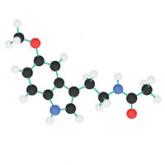PURLs

Consider Melatonin for Migraine Prevention
Melatonin holds more power than your average sleep aid—at least for patients with chronic migraine. Their dreams of migraine-free days just may...
Jennie B. Jarrett is with the University of Chicago. David Moss is with Nellis Air Force Base Family Medicine Residency in Las Vegas.
An inexpensive and well-tolerated anticholinergic reduces sweating in patients with localized—and generalized—hyperhidrosis.
A 34-year-old woman presents to your office for unbearable sweating on her hands, face, and axillary regions. It occurs nearly daily, causing social embarrassment. She has tried multiple antiperspirants to no avail. What can she can take to reduce the sweating?
Hyperhidrosis is a common, self-limiting problem that affects 2% to 3% of the United States population.2 Patients may complain of localized sweating of the hands, feet, face, or underarms, or more systemic, generalized sweating in multiple locations. Either way, patients note a significant impact on their quality of life.
Treatment of hyperhidrosis has traditionally focused on topical therapies to the affected areas. Research by both subjective report and objective measurements has shown that antiperspirants containing aluminum salt are effective at reducing sweating, particularly in the axilla, hands, and feet.3,4 Additionally, a systematic review of observational and experimental studies found topical glycopyrrolate to be efficacious for craniofacial hyperhidrosis, with minimal adverse effects.5 The availability of low-cost prescription and OTC aluminum-based antiperspirant agents makes topicals the firstline choice.
More invasive treatments are available for hyperhidrosis refractory to topicals. In a double-blind RCT, researchers injected either botulinum toxin type A (BTX-A) 50 U or placebo in patients with bilateral primary axillary hyperhidrosis.6 Of the 207 patients who received treatment injections, 96.1% had at least a 50% reduction of axillary sweating four weeks after initial injection, as measured by gravimetric assessment. The BTX-A injections also produced a prolonged effect; mean duration between injections was 30.6 weeks.
Other invasive treatments include iontophoresis, surgery, and laser therapy; however, these methods are not suitable for body-wide application and are thus not appropriate for patients with generalized hyperhidrosis.
Oxybutynin is the first oral agent to emerge as a treatment option for hyperhidrosis. This cholinergic antagonist has historically been used to treat overactive bladder. But oxybutynin not only reduces urinary frequency, it also decreases secretions in various locations and can therefore reduce perspiration and cause dry mouth.
In one prospective placebo-controlled trial, 50 patients with generalized hyperhidrosis were randomly assigned to either oxybutynin (titrated from 2.5 mg orally once daily to 5 mg orally twice daily) or placebo for six weeks.7 Seventeen patients (73.9%) receiving oxybutynin for palmar or axillary hyperhidrosis reported moderate to “great” resolution of their symptoms, compared with six patients (27.3%) in the placebo group. Dry mouth was reported in 34.8% of patients receiving oxybutynin versus 9.1% of those who received placebo; however, no patients dropped out of the study due to this adverse effect.7
This multicenter RCT compared oxybutynin to placebo in 62 adults with localized or generalized hyperhidrosis from 12 outpatient dermatology practices in France. It is the first study to include patients with both localized and generalized forms of the condition.
Patients were included if they were older than 18, enrolled in the National Health Insurance system in France, and reported a Hyperhidrosis Disease Severity Scale (HDSS) score ≥ 2. The HDSS is a validated, one-question tool (“How would you rate the severity of your sweating?”). Patients provide a score of 1 (no perceptible sweating and no interference with everyday life) to 4 (intolerable sweating with constant interference with everyday life).8 Patients were excluded if they had any contraindications to the use of an anticholinergic medication.
Patients randomly assigned to oxybutynin took 2.5 mg/d by mouth initially and increased gradually over eight days until reaching an effective dose that was no more than 7.5 mg/d. They then continued at that dose for six weeks.
The primary outcome was improvement on the HDSS by one or more points, measured at the beginning of the trial and again at six weeks. Secondary outcomes included change in quality of life, as measured by the Dermatology Life Quality Index (DLQI) and reported adverse effects. The DLQI is a dermatology-specific quality-of-life measure consisting of 10 questions. Scores range from 0 (where disease has no impact on quality of life) to 30 (maximum impact of disease on quality of life).9
Improved HDSS and DLQI scores. Most patients (83%) in the study had generalized hyperhidrosis. Patients were in their mid-30s. Sixty percent of patients in the oxybutynin group had an improvement of one point or more on the 4-point HDSS, compared to 27% in the placebo group. DLQI scores improved by 6.9 points in the oxybutynin group and 2.3 points in the placebo group.
The most common adverse effect was dry mouth, which occurred in 13 patients (43%) in the oxybutynin group and in three patients (11%) in the placebo group; it did not cause any patients to drop out of the study. The second most common adverse effect was blurred vision, which only occurred in the oxybutynin group (four patients; 13%).

Melatonin holds more power than your average sleep aid—at least for patients with chronic migraine. Their dreams of migraine-free days just may...
Should patients with medial degenerative meniscal tears always undergo surgery? Not according to a recent study, which suggests physical therapy...
The benefits of smoking cessation are well known ... but being cognizant of the dangers of cigarettes and actually kicking the habit are two...
